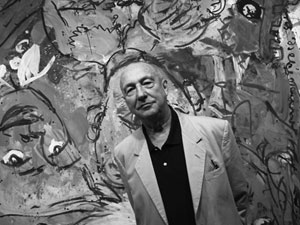
Roy Fox Lichtenstein was an American pop artist. During the 1960's, along with Andy Warhol, Jasper Johns, and James Rosenquist, he became a leading figure in the new art movement. His work defined the premise of pop art through parody. Inspired by the comic strip, Lichtenstein produced precise compositions that documented while they parodied, often in a tongue-in-cheek manner. His work was influenced by popular advertising and the comic book style. His artwork was considered to be "disruptive". Lichtenstein described pop art as "not 'American' painting but actually industrial painting". His paintings were exhibited at the Leo Castelli Gallery in New York City.

Sir Anthony Douglas Cragg is an Anglo-German sculptor, resident in Wuppertal, Germany since 1977.

Sir Antony Mark David Gormley is a British sculptor. His works include the Angel of the North, a public sculpture in Gateshead in the north of England, commissioned in 1994 and erected in February 1998; Another Place on Crosby Beach near Liverpool; and Event Horizon, a multipart site installation which premiered in London in 2007, then subsequently in Madison Square in New York City (2010), São Paulo, Brazil (2012), and Hong Kong (2015–16).

Georg Baselitz is a German painter, sculptor and graphic artist. In the 1960s he became well known for his figurative, expressive paintings. In 1969 he began painting his subjects upside down in an effort to overcome the representational, content-driven character of his earlier work and stress the artifice of painting. Drawing from myriad influences, including art of Soviet era illustration art, the Mannerist period and African sculptures, he developed his own, distinct artistic language.

Richard Serra was an American artist known for his large-scale abstract sculptures made for site-specific landscape, urban, and architectural settings, and whose work has been primarily associated with Postminimalism. Described as "one of his era's greatest sculptors", Serra became notable for emphasizing the material qualities of his works and exploration of the relationship between the viewer, the work, and the site.

George Warren Rickey was an American kinetic sculptor known for geometric abstractions, often large-scale, engineered to move in response to air currents.

Ion Irimescu was one of Romania's greatest sculptors and sketchers as well as a member of the Romanian Academy. In 2001 he was awarded the Prize of Excellence for Romanian Culture. He is often referred to as the "patriarch of Romanian art and sculpture".

Nicholas Mukomberanwa, was a Zimbabwean sculptor and art teacher. He was among the most famous protégés of the Workshop School at the National Gallery of Zimbabwe. He was a mentor to the Mukomberanwa Family of sculptors. Mukomberanwa married his first wife, sculptor Grace, in 1965 and they had eight children. In 1965, he decided to end his career with the police to become a sculptor full-time. He continued to hone his skills over the following decade, developing one of the most distinctive personal styles found in his generation of Zimbabwean stone sculptors. The gambit paid off, and by the late 1970s and in the 1980s his work was being shown in many venues. His work has been exhibited in galleries around the world. He also became mentor to many artists in Zimbabwe, including his children Anderson Mukomberanwa, Ennica Mukomberanwa, Lawrence Mukomberanwa, Netsai Mukomberanwa, Taguma Mukomberanwa,Tendai Mukomberanwa and nephew, Nesbert Mukomberanwa who are also sculptors. He remains one of Zimbabwe's most famous artists.

Satoru Abe is a Japanese American sculptor and painter.

Ron Nagle is an American sculptor, musician and songwriter. He is known for small-scale, refined sculptures of great detail and compelling color.

Stanislav Libenský and Jaroslava Brychtová were Czech contemporary artists. Their works are included in many major modern art collections, such as the Metropolitan Museum of Art and the Victoria & Albert Museum.

Viive Sterpu was an Estonian artist married to fellow artist Eugen Sterpu. She lived and worked in Tallinn, Estonia.
Jüri Okas is a notable Estonian architect, installation artist and printmaker.
Juozas Lebednykas was a Lithuanian artist and sculptor.

Tudor Cataraga was a sculptor from the Republic of Moldova.

Francis Neil Dawson is a New Zealand artist best known for his large-scale civic sculptures.

Kaarel Kurismaa is the first and one of the most important sound art and sound installation artists in Estonia. His work also expands into the field of painting, animation, public space monumental art, stage installations. In Estonian art history, Kurismaa’s significance lies mostly in the pioneering work with kinetic art and with keeping its traditions alive. Kurismaa stands as one of Estonian sound art scene’s central icons. His idiosyncratic work serves as a foundation for Estonian sound and kinetic art.
Ülo Õun was an Estonian sculptor whose career began in the late 1960s and came to prominence in the 1970s. Õun mainly worked as a portrait and figural sculptor and was known for his works in colored plaster and bronze.
Erich Leps was an Estonian painter.















